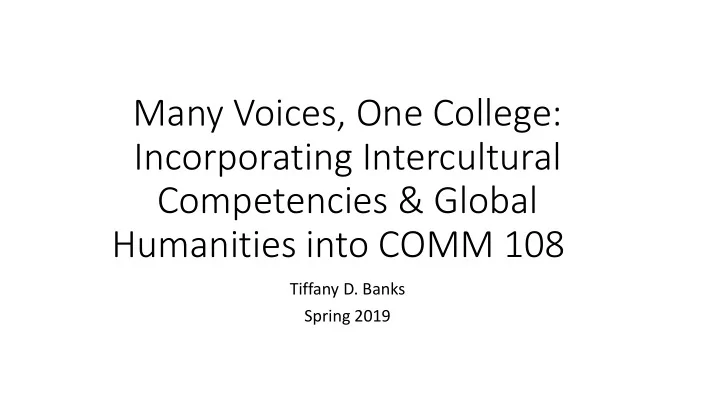

Many Voices, One College: Incorporating Intercultural Competencies & Global Humanities into COMM 108 Tiffany D. Banks Spring 2019
Who is Equal? How d w did w we Who is Included? become me U U.S? Who is Free?
Reproduction of Slave Inventory • Sex • Age • Skin Tone
Who is Equal? Who is Included? How d w did w we become me U U.S.? Who is Free? Who frames the narrative?
Big Idea: Using a Cultural Wealth framework enables us to replace deficit- centered narratives to asset-centered narratives.
Modu dule Title: “Reframing the Narrative: Understanding the Communication Model Through Cultural Wealth Framework” Cultural Captial (Yosso, 2005) includes the languages, skills, knowledges, and social practices communities of color and traditionally marginalized groups use to survive and resist various forms of oppression. Cultural capital offers valuable insights on resistance to navigate everyday social life.
Form rms of C Cultural Capital: 1. aspirational, 2. linguistic, 3. familial, 4. social, 5. navigational, and 6. resistance.
Learning Competencies: • Knowledge of one’s own culture and history • Sensitivity and respect for personal and cultural differences • Empathy and the ability to see multiple perspectives • Self-awareness and self-esteem about one’s own identity and culture • Communication skills, including the ability to use another language effectively and interact with people from other cultures • Insights into how our actions and ideas influence the world in which they live
Summati tive Assessment: Self-Concept Paper: Students will write a three to five-page essay where they discuss how their sense of “self” arises in communication with others by examining their interactions and everyday life experiences. • Students will identify a dominant narrative that has impacted their self- concept. Students will offer a re-telling or reframing of the deficit-centered narrative.
Resou ources es: • Film: “This is Home” A Syrian Refugee Story • TedTalk: “The Danger of a Single Story by Chimamanda Ngozi Adichie • Poem: “I, too, am America” by Langston Hughes • Prose: “The House on Mango Street” by Sandra Cisneros • Prose: “The Truth About Stories: A Native Narrative” Yosso, T.J., (2005). Whose culture has capital? Race, Ethnicity and Education, 8(1), pp. 69-91.
Who is Equal? Who is Included? How d w did w we become me U U.S.? Who is Free? Who frames the narrative?
Recommend
More recommend